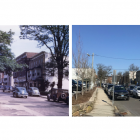Around Town
New Canaan Now & Then: Vine Cottage
|
According to Mary Louise King, 61 Main Street, or “Vine Cottage” was probably built in 1859 by the Sea Captain Sereno Ogden.
Its history began with Edward Nash, a silversmith who came to New Canaan in 1809 and lived where Town Hall is today. Nash partnered with Stephen Hoyt, Jr. in Hoyt & Nash, the general store at the corner of Main Street and East Avenue. When Nash died in 1836, his homestead extended from Morse Court to the Red Cross building. His daughter Hannah Nash inherited most of this property. When she died, she left the property to her young son Edward, but it was in the control of his guardian, her husband, Sereno Ogden.
Mary Louise King speculates that Vine Cottage was built by Ogden for Albert Comstock, who ran a men’s clothing business, and his wife, Cornelia Carter. Cornelia Carter Comstock was the founder of the Hannah Benedict Carter chapter of the Daughters of the American Revolution (it is named for her mother), and Albert Comstock was a founder of the Historical Society in 1889. The architectural changes, including Gothic additions and a front porch, were probably done in the 1860s by the Comstocks. They sold the house with one acre to Stephen Pardee in 1871 for $4,500. “New Canaan Now & Then” is presented in partnership with the New Canaan Museum & Historical Society.




